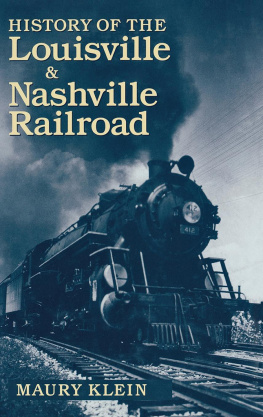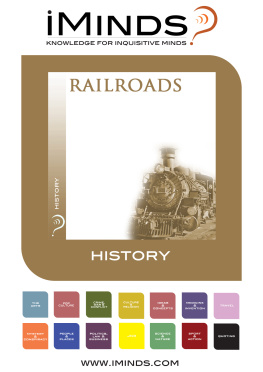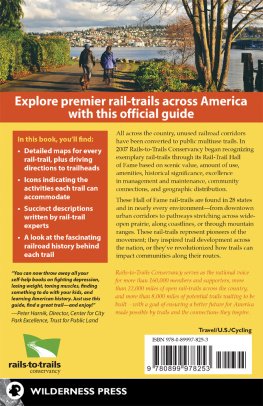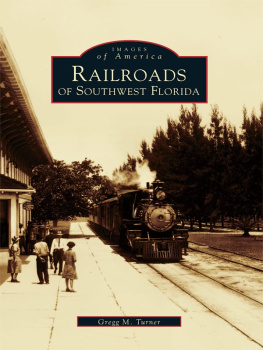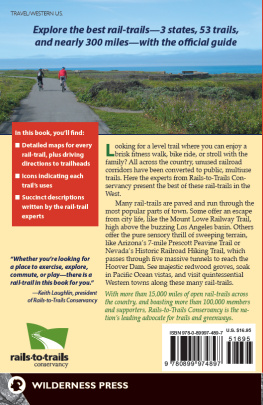Railroads of
Pennsylvania
2ND EDITION
Lorett Treese
STACKPOLE
BOOKS
Copyright 2012, 2003 by Stackpole Books
First edition published 2003. Second edition 2012
Published by
STACKPOLE BOOKS
5067 Ritter Road
Mechanicsburg, PA 17055
www.stackpolebooks.com
All rights reserved, including the right to reproduce this book or portions thereof in any form or by any means, electronic or mechanical, including photocopying, recording, or by any information storage and retrieval system, without permission in writing from the publisher. All inquiries should be addressed to Stackpole Books.
Printed in the United States of America
10 9 8 7 6 5 4 3 2 1
Cover design by Tessa Sweigert
Front cover: The Pennsy at Broad Street Station by John Winfield
Back cover: Pennsylvanias Rockville Bridge by John Winfield
Both images used with permission of John Winfield, www.winfieldrailart.com
Library of Congress Cataloging-in-Publication Data
Treese, Lorett, 1952
Railroads of Pennsylvania / Lorett Treese. 2nd ed.
p. cm.
Includes bibliographical references and index.
ISBN 978-0-8117-0011-5 (pbk.)
1. RailroadsPennsylvaniaHistory. I. Title.
HE2771.P4T74 2012
385.09748dc23
2012017243
eBook ISBN: 978-0-8117-4887-2
CONTENTS
SECTION FIVE: Upstate Pennsylvania
PREFACE
Picking Up the Pieces
In 1812, John Stevens, sometimes called the father of American railroads, published Documents Tending to Prove the Superior Advantages of Rail-Ways and Steam-Carriages over Canal Navigation. It was a groundbreaking pamphlet because it proposed the construction of a railroad at a time when America had no steam locomotives or passenger cars. Stevens envisioned a railway constructed of timber, its moving power to be a steam-engine that would burn wood. He thought that a railroad could be built more quickly and with fewer casualties than a canal, and that it would be no more expensive than a turnpike.
Although Stevens expected to be stigmatized as a visionary projector, he argued, Sooner or later, then, the improvement now proposed will be brought into general use, and, if I mistake not, long before the projected canal [the Erie Canal] will be completed. He might have been somewhat optimistic, but Stevens was right. Within another two decades, railroads were springing up all over the eastern United States, first as feeders to canals, then alongside the canals they were replacing.
Railroads may have been the best thing that ever happened to America. They opened markets, making it possible for geographically distant regions to be closely tied economically. Railroads greatly expanded the volume of trading on Wall Street and provided opportunities for many Americans to work, apply their ingenuity, and perhaps even earn a fortune.
In Pennsylvania, railroads transported natural resources like coal, oil, and lumber, as well as agricultural products, to urban consumers, and carried manufactured goods and machinery to rural areas. Cities like Philadelphia, Pittsburgh, Reading, and Harrisburg developed as railroad hubs, while towns like Altoona were founded to maintain railroad property. Railroads made the Commonwealth one of Americas leading industrial and richest states.
Pennsylvanias railroad mileage began to diminish around the time of the First World War. Passenger traffic began declining during the 1920s, and railroad freight volume joined the downward trend soon after World War II.
When I researched and wrote the first edition of Railroads of Pennsylvania, I thought I was contributing to an era of railroad nostalgia that started in the 1930s, as well as the railroad heritage preservation and documentation efforts that continue today. The subtitle, Fragments of the Past in the Keystone Landscape, was inspired by the science-fiction time travel classic Time and Again, whose author, Jack Finney, used the word fragments to describe New Yorks vintage buildings and neighborhoods: fragments still remaining of days which once lay out there as real as the day lying out there now. Abandoned viaducts, rail-trails, and repurposed passenger stations were such fragments of Americas railroad past to me.
However, around the time Railroads of Pennsylvania was published in 2003, Americas railroad industry was changing. The U.S. economy was emerging from a recession, and the demand for consumer goods surged. Burlington Northern Santa Fe (BNSF) led the way in constructing a rail connection to link ports where foreign manufactured goods were received to population centers where consumers were waiting to purchase them. Railroads and rail yards soon begat warehouses and distribution centers.
Because fuel prices were rising and railroads could move freight using less fuel than trucks, trucking companies began loading trailers and containers on and off trains, causing the intermodal transportation industry to greatly expand. Truckers became railroad operators new best friends. So did environmentalists, who appreciated the reduced fuel emissions and highway congestion.
Conrail had been permitted to cease serving routes that were inefficient to its own operations but often critically important to local businesses, thus creating opportunities for short lines to become established and flourish. Today Pennsylvania has more short-line railroads than any other state. Pennsylvania short lines come in all sizes: some are mom-and-pop operations, while others are steadily growing through additions to their portfolios. The Commonwealths Class I railroads consider them important partners in providing customer service on a retail level.
Starting in the mid-1990s, decades of railroad abandonment slowly turned into railroad reconstruction. Railroads invested in improving their infrastructure, such as by straightening curves that slowed trains down and making tunnels bigger. This rebuilding effort is curiously reminiscent of what took place in the late nineteenth and early twentieth centuries, when a lot of the Commonwealths more impressive railroad structures were constructed, such as the Tunkhannock Viaduct in Nicholson and the stunning passenger stations of Pittsburgh.
Sometimes opportunities crop up suddenly, like the technology that made it possible to efficiently extract natural gas from the Marcellus Shale geological formation, which stretches through much of northern and southwestern Pennsylvania. Both Class I railroads and short lines quickly positioned themselves to transport the supplies and equipment necessary to the energy corporations exploiting this natural resource.
The digital revolution has also come to the railroad industry. Both trains and the tracks on which they operate are increasingly equipped with data-gathering devices enabling trains to run faster and safer. Pneumatic braking systems controlled by electronic signals instead of air pressure are perhaps the biggest breakthrough since the Westinghouse air brake.
In 2008, Berkshire Hathaway Inc. disclosed a significant investment in BNSF, and this vote of confidence from one of Americas most successful investors, Warren Buffett, alerted other investors to the growth potential for railroads. Although the industry suffered together with the rest of the economy in 2009, by mid-2010 Railway Age magazine was reporting that railroads were beginning to recall furloughed crews and take freight cars and locomotives out of storage. By the fall of that year, freight volume once again approached 2008 levels. In 2011, a number of railcar manufacturers reported increased sales, and the railroad resurgence was back on.



